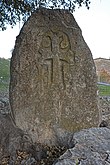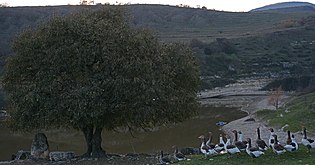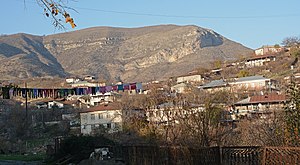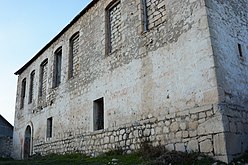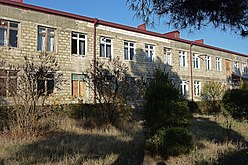|
Khnapat
Khnapat (Armenian: Խնապատ) or Khanabad (Armenian: Խանաբադ; Azerbaijani: Xanabad) is a village in the Khojaly District of Azerbaijan, in the region of Nagorno-Karabakh. Until 2023 it was controlled by the breakaway Republic of Artsakh. The village had an ethnic Armenian-majority population[2] until the exodus of the Armenian population of Nagorno-Karabakh following the 2023 Azerbaijani offensive in Nagorno-Karabakh.[3] HistoryThe modern village was founded in the early 19th century by settlers from the nearby Armenian mountain villages of Jrver and Yereshen.[4] During the Soviet period, the village was part of the Askeran District of the Nagorno-Karabakh Autonomous Oblast. Historical heritage sitesHistorical heritage sites in and around the village include the nearby ruined village of Jrver (Armenian: Ջրվեր, also known as Hanatak) from between the 12th and 17th centuries, the ruined village of Verin Ghlijbagh (Armenian: Վերին Ղլիջբաղ) from between the 12th and 19th centuries 3 km to the west of Khnapat, a 9th/13th-century khachkar, a chapel built in 1224, the medieval cave-shrine of Mets Nan (Armenian: Մեծ նան), a 17th-century cemetery, the ruined village of Yereshen (Armenian: Երեշեն) from between the 18th and 20th centuries, the 19th-century church of Surb Astvatsatsin (Armenian: Սուրբ Աստվածածին, lit. 'Holy Mother of God'), and a 19th/20th-century cemetery.[1][4] Economy and cultureThe population is mainly engaged in agriculture and animal husbandry, as well as in different state institutions. As of 2015, the village has a municipal building, a house of culture, a secondary school, a music school, a kindergarten, three shops, and a medical centre.[1] DemographicsAccording to the records of the self-proclaimed rejime, the village had 827 inhabitants in 2005,[5] and 1,042 inhabitants in 2015.[1] Gallery
References
External linksWikimedia Commons has media related to Xanabad. |
||||||||||||||||||



